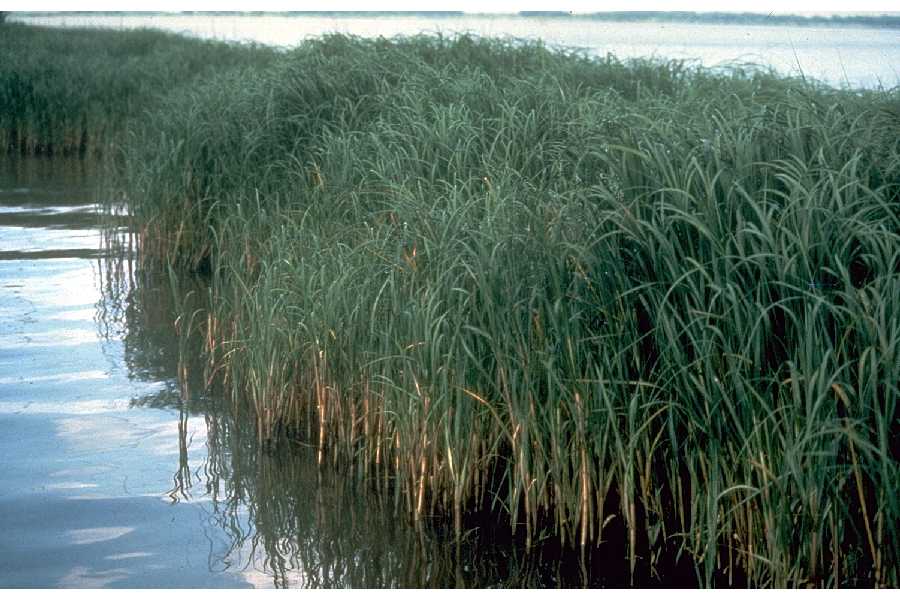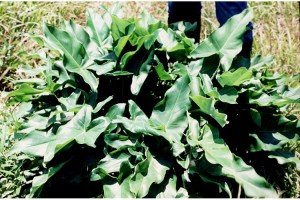21 November 2012
Salt-spitting grass could rescue marsh from sea-level rise
Posted by kramsayer

Smooth cordgrass is native to saltwater marshes on the East Coast. (Credit: USDA-NRCS PLANTS Database)
Reston, Va. – Sweet Hall Marsh along the Pamunsky River in Virginia hasn’t been able to keep pace with rising seas, putting it in danger of being flooded. But the emergence of a grass that is a stranger to the marsh could turn out to be its savior.
Sweet Hall Marsh is a freshwater marsh normally dominated by arrow arum, an herbaceous plant with broad arrow-shaped leaves. But smooth cordgrass, a 3-foot-tall grass that is native to the area’s saltwater marshes, has taken root in parts of the freshwater ecosystem. Lori Sutter, a wetland ecologist with the Virginia Institute of Marine Science, said this was surprising because the cordgrass usually has trouble competing with freshwater plants.
“All we know suggests that it shouldn’t be there,” Sutter said.
Sutter presented her research on the Sweet Hall Marsh cordgrass on Nov. 14 at the Chapman Conference on Hydrogeomorphic Feedbacks and Sea Level Rise in Tidal Freshwater River Ecosystems, held in Reston, Va.
The ability of the cordgrass to move into arrow arum’s space is a sign that the marsh is becoming more salty, she said, a common problem tied to sea level rise. When the rising oceans push more salt into wetlands that are normally full of freshwater, it can disrupt the entire ecosystem by, for example, giving new species that can handle the salt a chance to dominate the landscape.

Arrow Arum recently lost some ground to saltwater cordgrass at Sweet Hall Marsh, a sign that saltwater is intruding on the marsh. (Credit: USDA-NRCS PLANTS Database)
The cordgrass survives the salty environment by acting as its own water filter. It screens the salt out of the water and then ejects it back into the environment through tiny holes in its leaves. “Just like you or I can’t drink saltwater and survive, the same is true of plants,” Sutter explained. “So it actually takes that salt, and it stores it, and it spits it out.” Oftentimes, she noted, you can see the salt lining the blade of grass like a trail of salty drool.
But, even though it would change the marsh’s ecology, smooth cordgrass might actually save Sweet Hall Marsh by helping the wetland rise along with the sea level. Arrow arum doesn’t take up much space close to the ground because its leaves spread outward from a thick central stem. But smooth cordgrass typically grows straight up, instead of spreading outward, and stems bunch up close to the ground, slowing down any water flowing through the patches of grass. Since the water meets more resistance, it’s more likely to drop sediment on the marsh.
“The cordgrass just really lock it in,” said Sutter. “There’s just this mesh of organic material.”
Sutter said this is a source of hope for scientists worried that rising sea level may flood Sweet Hall Marsh. “The plant community’s likely to change, it’s likely to shift to a smooth cordgrass dominated marsh, which has other issues,” said Sutter. “But at least it’s a marsh.”
That doesn’t mean it’s wise to intentionally introduce the grass to endangered marshes in other regions, Sutter said. The cordgrass is not welcome in other parts of the world, such as the West Coast and China, where it rapidly spreads and dominates some wetlands. In England, smooth cordgrass has even crossbred with native plants and created its own species.
“I live on the West Coast, and they hate that stuff. It’s like the evil empire,” said geomorphologist Greg Pasternak of the University of California. “It takes over; outcompetes everything there.”
-Sean Treacy, AGU science writing intern










 GeoSpace is a blog on Earth and space science, managed by AGU’s Public Information staff. The blog features posts by AGU writers and guest contributors on all sorts of relevant science topics, but with a focus on new research and geo and space sciences-related stories that are currently in the news.
GeoSpace is a blog on Earth and space science, managed by AGU’s Public Information staff. The blog features posts by AGU writers and guest contributors on all sorts of relevant science topics, but with a focus on new research and geo and space sciences-related stories that are currently in the news.